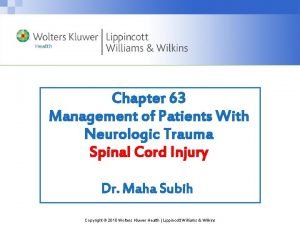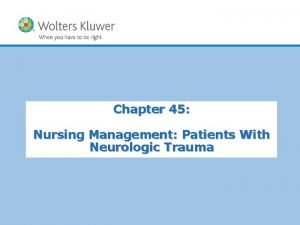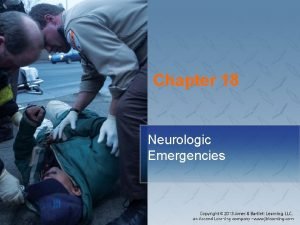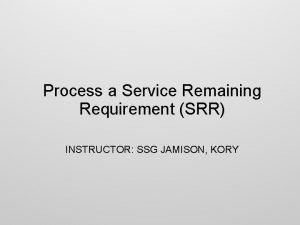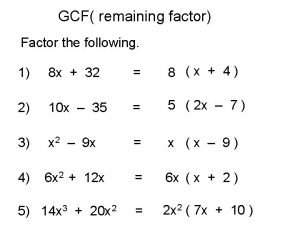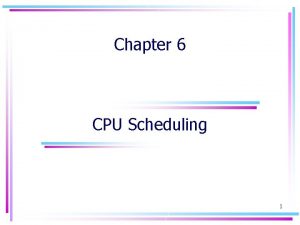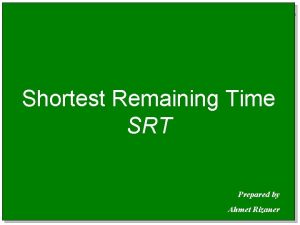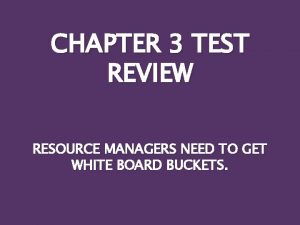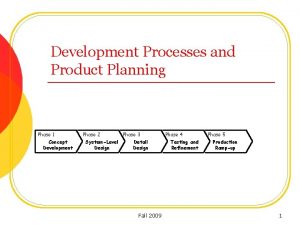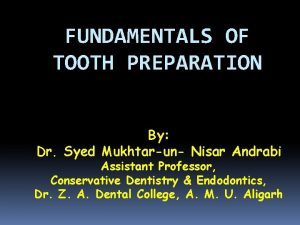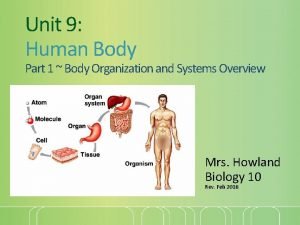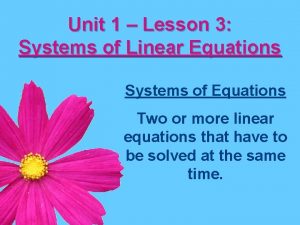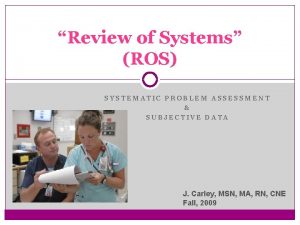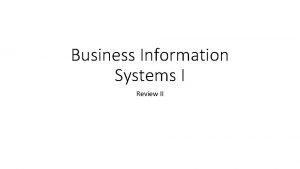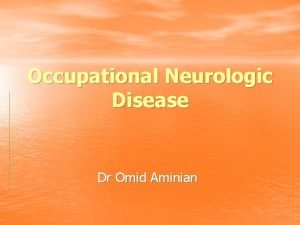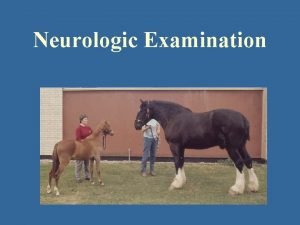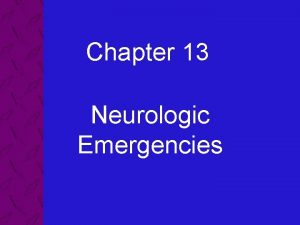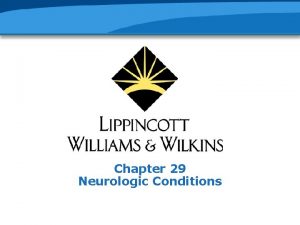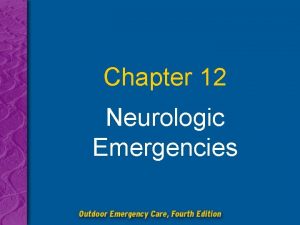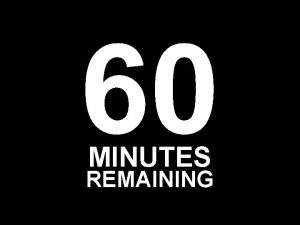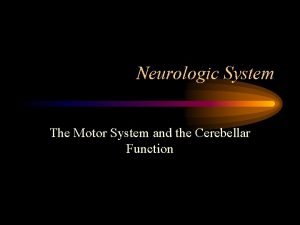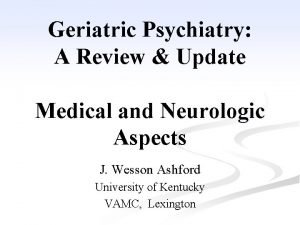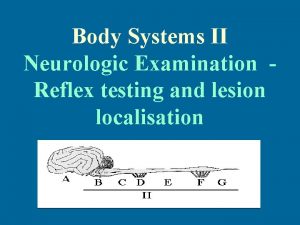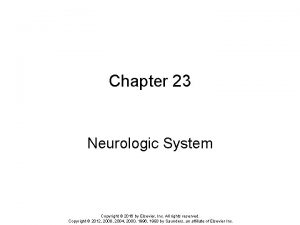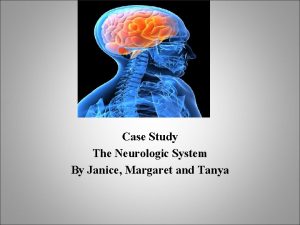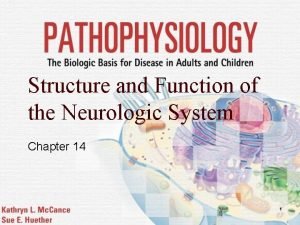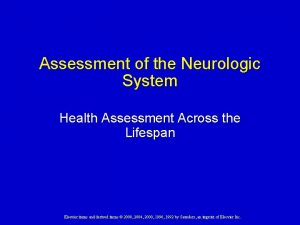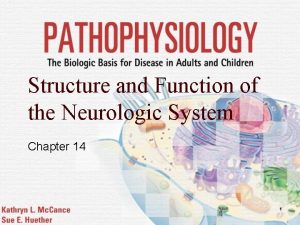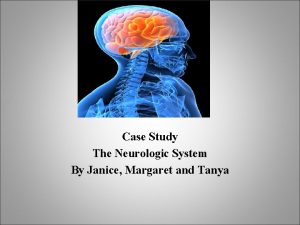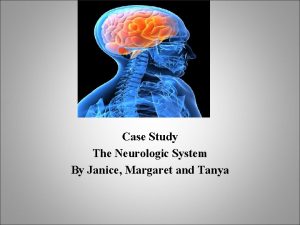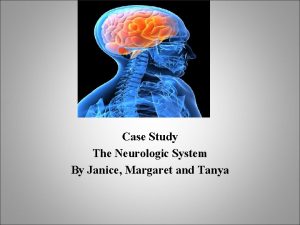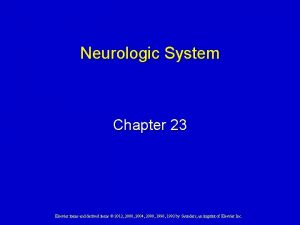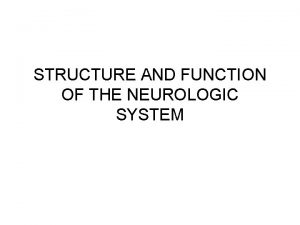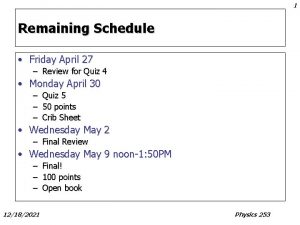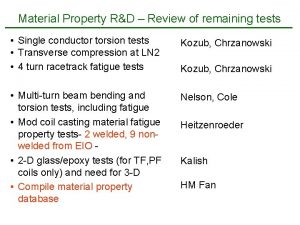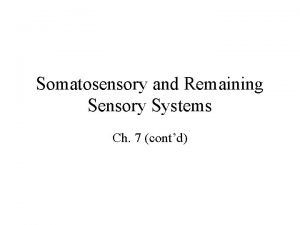Remaining Neurologic System Review of Systems o o































- Slides: 31

Remaining Neurologic System

Review of Systems o o o o Decreased LOC Confusion Headache/Pain History of head injury or major trauma Clumsiness/decreased coordination or balance Seizures Fainting spells Dizziness o o Physical disability Numbness or tingling Sudden change in vision or hearing Behavioral changes n o o Attention, mood, speech, insight, judgment, orientation, or memory Psychiatric symptoms Aphasia

Complete Neurological Assessment o Cerebral Function n o o Mental Status Cranial Nerve Function Sensory Function Motor Function Reflexes

Sensory Function

Sensory Function- A&P Review

Common Sites for Referred Pain © Pat Thomas, 2006.

Dermatomes o A band of skin innervated by the sensory root of a single spinal nerve


Sensory Function. Spinothalamic Tract o Superficial sensation n Pain o o n Temperature o n Assess sharp and dull Allow at least 2 sec between Test only when pain sensation abnormal Light (crude) touch Apply wisp of cotton to arms, forearms, hands, chest, thigh, an legs Sharp and dull and light touch intact o

Sensory Function. Spinothalamic Tract o Scatter stimuli so as to sample most dermatomes and peripheral nerves n n n n Both shoulders (C 4) Inner and outer aspects of forearm (C 6, T 1) Thumbs and little finger (C 6, C 8) Front of both thighs (L 2) Medial and lateral aspects of both calves (L 4, L 5) Little toe (S 1) Medial aspect of each buttock (S 3)


Sensory Function. Posterior Column Tract o Deep sensation n Vibration o o Use low pitch tuning fork (128 0 r 256 Hz) Place over bony surface of fingers and great toe n n Vibration intact Position (Kinesthesia) o Move finger or big toe up or down and ask which way move n Kinesthesia intact

Sensory Function. Posterior Column Tract o Discriminatory sensations n Stereognosis o Recognize objects n Stereognosis intact. n Graphesthesia o Read number traced on hand n Graphesthesia intact n Two-point discrimination o Distinguish separation of two stimuli n No longer perceives two separate points at ___mm

Motor Function

Motor Function- A&P Review

Motor Function- Muscles o Muscle size & symmetry n o Palpate major muscle groups of arms & legs Muscle Tone n While at rest and with passive movement o Normal, flaccid, spastic, or rigid

Muscle Strength o Muscle Strength Testing n n n o Arm Flexion & Extension Grip Strength Hip Flexion & Extension Thigh Adduction and Abduction Knee Flexion & Extension Ankle Dorsiflexion & Plantar Flexion Ask to lift extremity against gravity and the against resistance n 5/5 - Full ROM against gravity, full resistance n 4/5 - Full ROM against gravity, some resistance 3/5 - Full ROM with gravity 2/5 - Full ROM with gravity eliminated (passive) 1/5 - Slight contraction 0/5 - No contraction No atrophy, weakness, or tremors n n

Motor Function- Cerebellar Function o Balance tests n Gait o Walk 10 -20 feet, turn, and walk back the other way n o Tandem walk n n Gait smooth & coordinated Able to tandem walk Romberg Test o o Feet together, arms at side, and eyes closed and hold 20 seconds No swaying = negative Romberg

Motor Function- Cerebellar Function o Coordination & Skilled Movements n Rapid alternating movements (RAM) o Patient pats knees with front and back of hands quickly n n Rapid alternating movements quick and accurate Finger-to-finger test o o Touch thumb to each finger on same hand quickly Watch for cerebellar tremor (intention tremor) n n Tremor of extremity that occurs at end of purposeful mvmt. Caused by lesion/damage to cerebellum from stroke, tumor, MS, inherited degenerative disorders Finger to finger test smooth and accurate

Motor Function- Cerebellar Function n Touch thumb to each finger on same hand n n Thumb opposition quick and accurate Finger-to-nose test o With eyes closed patient touches tip of his/her nose quickly with index finger, alternating hands n Finger to nose smooth and accurate http: //www. youtube. com/watch? v=90 a 5 c. I 7 w. Dc. Y&featu re=related

Reflexes

Reflexes- A&P Review

Reflexes o Deep Tendon Reflexes (DTR) n n n o Biceps (C 5 -C 6) Triceps (C 7 -C 8) Brachioradialis (C 5 -C 6) Quadriceps (Patellar) (L 2 -L 4) Achilles (L 5 -S 2) Superficial Reflexes n n Plantar Reflex/Babinski (L 4 -S 2) Abdominal Reflexes (Upper T 8 -T 10) (Lower T 10 -T 12) n Crematic Reflex (L 1 -L 2)

Biceps Reflex o o o Place your thumb or finger firmly on the biceps tendon. Strike with the reflex hammer so that the blow is aimed through your thumb toward the biceps tendon Observe flexion at the elbow, and watch for and feel the contraction of the biceps muscle n Biceps reflex 2+ bilaterally

Triceps Reflex o o Strike the triceps tendon above the elbow Watch for contraction of the triceps muscle and extension at the elbow n Triceps reflex 2+ bilaterally

Brachioradialis Reflex o o Strike forearm approximately 2 -3 cm above radial styloid process Watch for flexion and supination of the forearm n Brachioradialis reflex 2+ bilaterally http: //www. youtube. com/watch? v=3 z. Um 0 u. Wn 6 c. E&feature=related

Quadriceps (Patellar) Reflex o o Briskly tap the patellar tendon just below the patella Note contraction of the quadriceps with the extension at the knee n Patellar reflex 2+ bilaterally http: //www. youtube. com/watch? v=_GS 2 b. MQLg. Pw&feature=fvwrel

Achilles Reflex o o Dorsiflex the foot at the ankle Have the patient relax Strike the Achilles tendon Watch and feel for plantar flexion at the ankle n Achilles reflex 2+ bilaterally

Plantar Reflex o o Stroke the lateral aspect of the sole from the heel to the ball of the foot, curving medially across the ball Note movements of the toes, normally plantar flexion Plantar reflex with down going toes/Negative Babinski http: //www. youtube. com/watch? v=o. I_ONptx 2 Ns&feature=related

Basic Neurological Exam/Recheck o o Affect Level of Consciousness n o o o Degree of wakefulness/ responsiveness to environment Orientation Speech Pattern Facial Symmetry Ability to Follow 1 Step Commands Direct & Consensual Pupillary Response & Accomodation Hand Grasps & Foot Pushes

Testing for Meningitis o Kernig’s sign n In supine position flex knee and hip of one leg to 90 degrees, then gently try to straighten leg. Positive if pain in low back and hamstring and of knee won’t straighten more than 135 degrees Negative Kernig’s sign http: //www. youtube. com/watch? v=r. J-5 AFu. P 3 YA&feature=related o o Brudzinski’s sign n In supine position place one hand behind patient’s neck and lift off of bed trying to touch chin to chest. o o Positive if hips and knees involuntarily flex Negative Brudzinski’s sign
 Lippincott williams & wilkins
Lippincott williams & wilkins Management of patients with neurologic trauma
Management of patients with neurologic trauma Chapter 18 neurologic emergencies
Chapter 18 neurologic emergencies Chapter 17 neurologic emergencies
Chapter 17 neurologic emergencies Srr extension
Srr extension Antecedent passion vs consequent passion examples
Antecedent passion vs consequent passion examples Which was easier finding the remaining factor
Which was easier finding the remaining factor Shortest remaining time first scheduling
Shortest remaining time first scheduling What is shortest remaining time srt scheduling
What is shortest remaining time srt scheduling Delayed differentiation and modular design
Delayed differentiation and modular design Divide remaining
Divide remaining Complete the scale by labeling the remaining tick marks
Complete the scale by labeling the remaining tick marks Staying faithful to god in hard times
Staying faithful to god in hard times Srtf and sjf
Srtf and sjf Plan the remaining development project
Plan the remaining development project Fundamentals of cavity preparation
Fundamentals of cavity preparation Chapter review motion part a vocabulary review answer key
Chapter review motion part a vocabulary review answer key Uncontrollable spending ap gov
Uncontrollable spending ap gov Nader amin-salehi
Nader amin-salehi What is inclusion and exclusion
What is inclusion and exclusion Narrative review vs systematic review
Narrative review vs systematic review Body organization
Body organization Pltw human body systems final exam review
Pltw human body systems final exam review Review of systems example
Review of systems example Unit 1 lesson 3 review of linear systems
Unit 1 lesson 3 review of linear systems Subjective review of systems
Subjective review of systems Review of business information systems
Review of business information systems Decision support systems and intelligent systems
Decision support systems and intelligent systems Principles of complex systems for systems engineering
Principles of complex systems for systems engineering Embedded systems vs cyber physical systems
Embedded systems vs cyber physical systems Elegant systems
Elegant systems Closed open and isolated systems
Closed open and isolated systems
